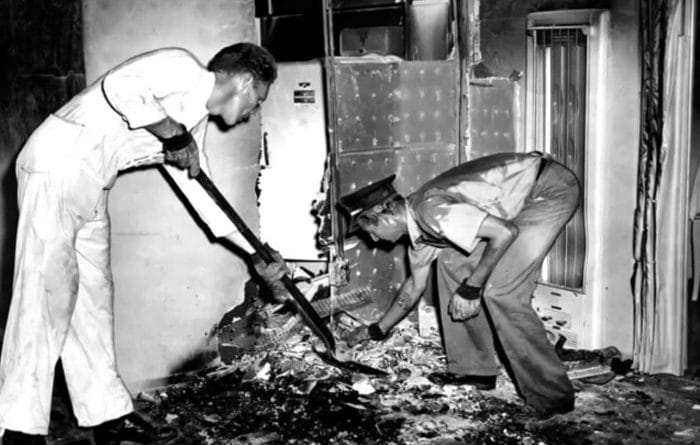Human Combustion on Cherry Street
November 27, 2019

At one local event, a woman saw my book, Supernatural St. Petersburg and Paranormal Pinellas. She eyed it for a minute, and then asked if the story of her grandmother was in that book.
“Your grandmother?” I asked.
“Yes. Mary Reeser was my grandmother.”
I was shocked as Mary Reeser is at the heart of one of the most famous cases of spontaneous human combustion in modern history. I remember reading about the case when I was in middle school and wondering how just such a thing could happen. When I was going through for my first graduate degree, I worked with a woman who was the daughter-in-law of the detective in charge of the case (Boyd). She said that her father-in-law had been contacted about the case for years, up until his death.
As we talked, this lady, Nancy Reeser, agreed to meet for an interview. She was delighted that I was planning to add a SPIRITS of St. Petersburg page to the website and a chapter to the next edition of Supernatural St. Petersburg and Paranormal Pinellas. After all, she’s lived with the story of her grandmother’s death for nearly 70 years.
According to Nancy, Mary Reeser was from Columbia, a town of 12,000 people in Pennsylvania. After Mary’s husband, Dr. Richard Reeser, had died, she sold their brownstone and opted to move to Florida. Her only son, Dr. Richard Reeser Jr., his wife and their three granddaughters lived in St. Petersburg and she thought it was important to live closer to them. The move to West Central Florida, and her small apartment at 1200 Cherry Street, was something that she almost instantly regretted. The Florida heat was overwhelming to her. Also, she was well connected in her small northern town and spent a great deal of time socializing there; here she felt disconnected. Though she wanted to move home, there were issues with housing and transportation that were preventing her from heading back to Columbia.
Nancy, her siblings and parents went to visit Mary for a while on a warm day in July. After the family left, she changed into her nightgown, opened her windows to the hot summer air, popped two sleeping pills, and sat in her recliner to smoke a cigarette before bed. It was about 9 p.m.

That night, reports of a smoky smell were noted by people in the area including Mary’s landlady, Pansy Carpenter. The next morning, a Western Union deliveryman intercepted Pansy. He had tried to deliver a message to Mary Reeser, but intense heat coming from the door warded him away. Pansy also checked the door and found the doorknob too hot to touch. Not knowing what else to do, they contacted the fire department.
When the firemen broke into Mary Reeser’s apartment, the woman was gone. Soot and smoke filled the area. The majority of the damage appeared to center around a large pile of black ashes central to the room. Here, firefighters found Reeser’s lower left leg, its foot still clad in a silk slipper. The rubble contained a piece of her backbone, a coil from the chair, and her skull, which had shrunk to the size of a cup.
As the case became known, speculation ran rampant. Nancy said that she remembered theories ranging from lightning coming through the window to the manifestation of the devil in the apartment. The most commonly believed hypothesis, however, was spontaneous human combustion, or SHC. SHC is the belief that in certain cases, human bodies can suddenly explode into flames. Some believe that it can happen to overweight women with unique chemical composition, possibly fueled by the over-consumption of alcohol.
The Police Chief, J. R. Reichart, sent a letter to J. Edgar Hoover asking for help with this case. The F.B. I. took samples from throughout the apartment for analysis. The FBI ruled out:
- Lightning strikes on Reeser or the building
- Electrical fire
- Arson via combustible fluids, though any present may have burned away with the fire
However, the F.B.I. also said that they did not believe it was spontaneous human combustion. The most logical answer was that Mary had fallen asleep with her cigarette. The ash fell onto her rayon acetate nightgown which caught fire. The flames went into Mary’s body and fed off of her fatty tissues to do a slow burn.
An article written on the case by University of Pennsylvania anthropologist, Wilton M. Krogman. Krogman noted that Reeser’s remains were abnormal and rejected the FBI’s theory. According to Krogman:
- The skull should have exploded from the heat rather than shrunk.
- Much of her remains mimicked a state of cremation, and that would have required thousand degrees of heat over a course of several hours. Such heat should have caused the apartment to burn up as well.
- The undamaged lower leg, foot, and slipper that were also located with the ashes at the source of the fire
In the end, the Police Chief noted that this was by far the most bizarre case of his career.
The unusual phenomena did not end witht he closing of the case. Her remains were entrusted to her son, Richard, who buried some of the ashes next to the grave of his father in Pennsylvania. The family kept the remaining ashes, and eventually moved Mary’s furniture out of the apartment and into their home. Mary, it seems, also came along.
Nancy recalled how the family dog used to sit in front of one of Mary’s large chairs and act strangely – howling at it, though no one was there. They inherited her rocking chair, which they witnessed moving by itself. The family would smell Mary’s perfume, Geurlain Le Blue, wafting through their home. And there were rumblings in the downstairs of the home which they attributed to the ghost.

The activity died down though as Mary’s furniture was moved from the house. Today, Nancy said that her grandmother is no longer there. She believes that Mary has crossed over to the other side.
Interest in the case lasted for many years. In October 2019, the Tampa Bay Times ran an article re-capping the 70-year mystery. Nancy’s family kept a collection of items written about her grandmother.
“My father started to keep everything on this case,” she said. She handed me a scrapbook wrapped in a bag. Inside were several magazines, each marked where an article was published. She very generously donated these resources to the SPIRITS of St. Petersburg, and hopes to find more of the things that she and her family kept.
Works Consulted
Calise, Gabrielle. “Nothing Around Her.” Tampa Bay Times. 1B. October 26, 2019.
Reeser, Nancy. Personal interview. November 27, 2019.
